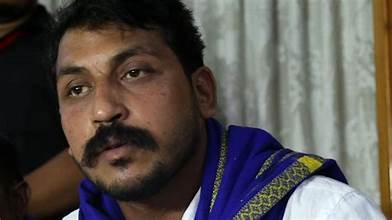In a recent turn of events, Chandrashekhar Azad, the Chief of Bhim Army, has once again captured the public’s attention. This time, his focus is on the controversial religious leader and storyteller, Rambhadracharya. Azad has urged the government to take swift action against Rambhadracharya, proposing imprisonment for the latter, and warning of direct action by his party, Bhim Army, if their demands are not met. This article delves into the details of this escalating controversy and explores its origins and potential implications.
The Spark of the Controversy: Rambhadracharya’s Contentious Remarks
The incident that set off this controversy occurred on January 8th during an event in Karpi Arwal, Bihar, where Rambhadracharya made a speech. In his address, he emphasized the worship of Lord Ram and allegedly made derogatory remarks about a specific caste for not chanting Ram’s name. When a video of his statement later surfaced on social media, it spread rapidly, igniting significant outrage among the members of the mentioned community. This led to widespread demands on social media for Rambhadracharya’s arrest, with the hashtag #ArrestRambhadracharya gaining momentum.
Chandrashekhar Azad Labels the Saint a ‘Hypocrite’
In response to the religious leader’s comments, Azad took to a microblogging platform (formerly Twitter) to express his disapproval. He described Rambhadracharya as a hypocrite, afflicted by casteist prejudice, and accused him of insulting the hardworking people of SC, ST, OBC communities and their revered figures. Azad emphasized that such caste-based discrimination is intolerable to the broader society and stated that a person’s worth should be judged by their actions, not caste.
Chandrashekhar Azad’s Aggressive Stance
Taking a more assertive tone, Azad warned the government to take immediate legal action against Rambhadracharya, threatening that the Bhim Army would take matters into its own hands if the government failed to respond. This stance has garnered support on social media, with many others condemning Rambhadracharya’s statement and echoing the demand for action.
Analyzing the Impact and Reactions
This incident has stirred a significant reaction, reflecting the ongoing tension surrounding caste-based discrimination in India. Chandrashekhar Azad’s role as a vocal advocate against casteism highlights a
continued struggle for equality and justice in the country. The public outcry, especially among the disadvantaged communities, underscores the deep-seated issues of caste prejudices and the need for their eradication from societal norms.
The Role of Social Media in Amplifying Voices
The role of social media in this controversy cannot be understated. It has acted as a catalyst, bringing widespread attention to Rambhadracharya’s remarks and mobilizing public opinion. The #ArrestRambhadracharya movement on social media platforms illustrates how digital activism can amplify marginalized voices and create pressure for institutional change.
Government’s Response and Legal Implications
The government’s reaction to these developments remains crucial. The demand for legal action against Rambhadracharya raises questions about the balance between free speech and hate speech, and the role of the government in regulating such matters. The call for Rambhadracharya’s arrest tests the legal frameworks in place for dealing with caste-based hate speech and their effectiveness in ensuring social harmony.
The Bhim Army’s Stance: A Fight for Justice or Vigilantism?
While the Bhim Army’s stance is seen as a fight for justice by its supporters, it also raises concerns about the potential for vigilantism. The threat of direct action by the Bhim Army if the government does not comply with their demands walks a fine line between advocacy and aggression. This aspect of the controversy highlights the challenges faced by social movements in their struggle for justice within the boundaries of law and order.
The Cultural and Social Dimensions
This incident is not just a political controversy but also reflects the deeper cultural and social dynamics in India. The caste system’s deep-rooted presence in Indian society and its impact on social interactions and perceptions are central to understanding the intensity of the reactions to Rambhadracharya’s comments.
Disclaimer : इस न्यूज़ पोर्टल को बेहतर बनाने में सहायता करें और किसी खबर या अंश मे कोई गलती हो या सूचना / तथ्य में कोई कमी हो अथवा कोई कॉपीराइट आपत्ति हो तो वह [email protected] पर सूचित करें। साथ ही साथ पूरी जानकारी तथ्य के साथ दें। जिससे आलेख को सही किया जा सके या हटाया जा सके ।















